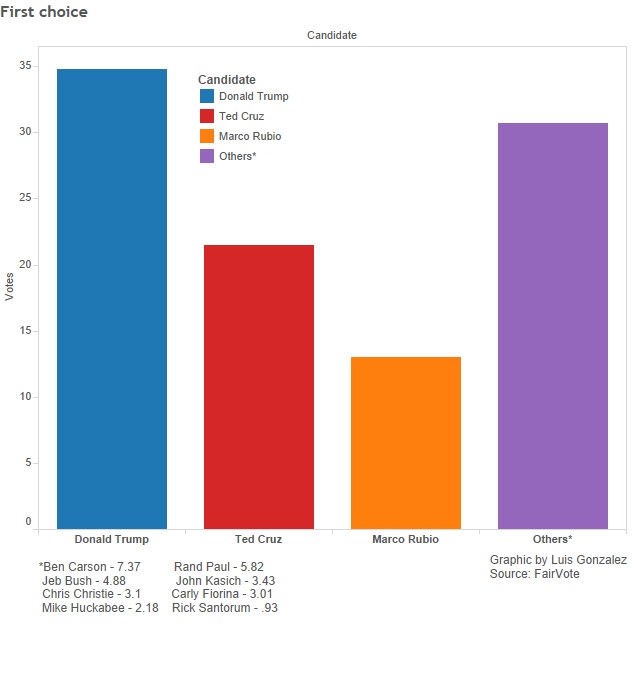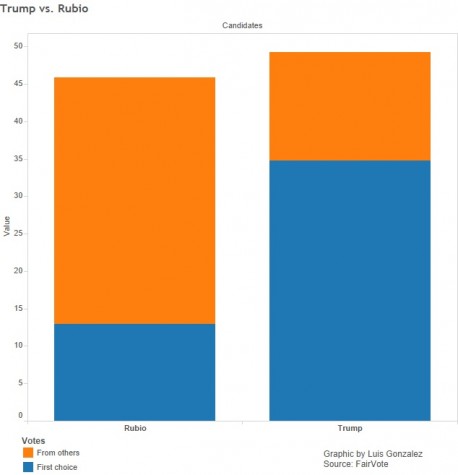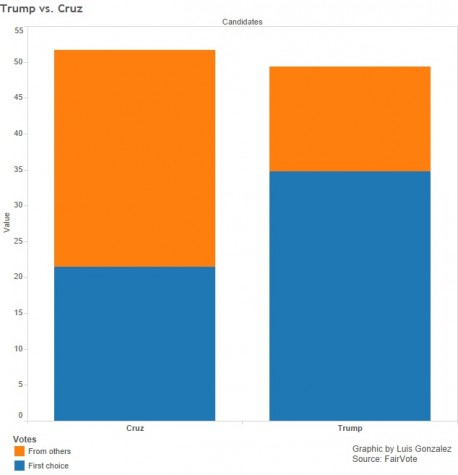WASHINGTON – As candidates drop out of the Republican presidential race and the field narrows, the comfortable lead Donald Trump enjoys over the rest of those vying for the Republican party’s presidential nomination could disappear.
Supporters of former Florida Gov. Jeb Bush and others who have dropped out will have to turn to different candidates now. FairVote, a nonpartisan electoral reform organization, and the College of William of Mary tried to figure out where those voters might go.
Through an online survey, 1,000 people who volunteered to answer questions and who self-identified as either Republican or independent voters, ranked all of the Republican presidential candidates instead of choosing one favorite.
FairVote used the results from this non-scientific poll to simulate which candidates would benefit as others dropped out of the race. The process is available to the public through an interactive website.
“These races are changing pretty regularly,” Rob Richie, co-founder and executive director of FairVote, said. “When you’re watching a debate, and you see Rubio say the same thing three times in a row, you can say, ‘I wonder what that’s gonna do?’ You can actually say let’s reduce Rubio’s vote and see who might pick up the votes.”
The survey was administered in two phases, one before to the Iowa caucuses, from Jan. 21 to Jan. 25, and again before the New Hampshire primary, from Feb. 4 to Feb. 8.
“The poll results are fascinating,” Emily Ekins, research fellow at the Cato Institute, said Thursday at a press conference about the survey. “I really like the idea of looking at this rank-choice voting to see where voters go if their first-choice candidate is no longer available.”
More than a third – 34.8 percent – of respondents named Donald Trump as their first choice. Ted Cruz came in at second place, with 21.5 percent.
Although the survey found Trump leading in first choices, he was also the most likely to be ranked last, providing other candidates the opportunity to close the gap.
“Donald Trump has a, what we all sort of know, strong and not-likely-to-go-away following,” said John Fortier, a political scientist and director of the Bipartisan Policy Center’s Democracy Project. “But he also has a ceiling, high negatives.”
According to the survey, that ceiling might still be high enough for Trump. After narrowing the race to two candidates, only Cruz beats Trump, but just by one point.
When Rubio, who polls in third in the first round with 13 percent, is Trump’s final opponent, Trump still wins handily.
After all other candidates’ votes are reallocated, Rubio does cut the original gap with Trump by more than half. He still loses the nomination to Trump by more than nine points.
Ekins said Rubio and Cruz both have a chance of beating Trump, but that the senators are taking votes from each other. The longer they both stay in the race, the higher the possibility of a Trump nomination.
“I think that’s something to watch. As these candidates start dropping out, I think the tug is going to be between Ted Cruz and Marco Rubio,” Ekins said. “Who’s going to last longer? And that actually could affect whether Donald trump is the nominee.”
Richie said information like the that in the survey helps inform the public much more than a simple first-choice poll. Knowing where the election is headed could affect their ballot choices.
“The voters, if they only get the information about who is ahead in the first choices, they’re getting a limited perspective of what’s really going on in the contest, where the trajectory of the contest might go,” Richie said. “It’s actually affecting how they might vote.”
Reach reporter Luis Gonzalez at [email protected] or 202-408-1493.












